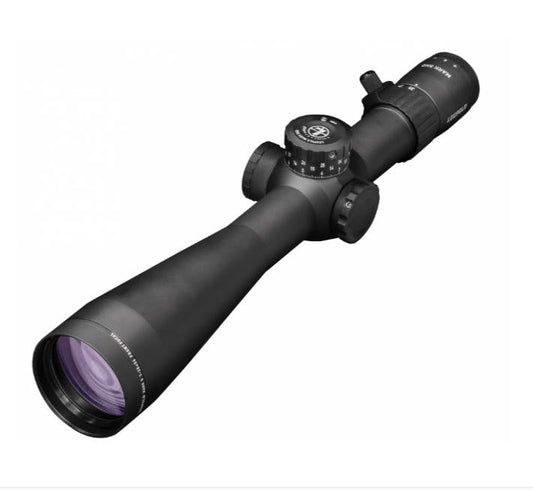

Product Description
Leupold Mark 5HD Rifle Scope - 7-35x56 (35mm) M5C3 FFP Illuminated TMR provides precise long-range targeting with a magnification range designed for accuracy at extended distances. The First Focal Plane (FFP) reticle allows for consistent subtension values at any magnification, ensuring you can make precise adjustments regardless of your target distance. Built with a 35mm maintube, this scope offers superior light transmission and clarity, making it ideal for low-light conditions. Constructed from rugged 6061-T6 aluminum, the Mark 5HD is both lightweight and durable, weighing in at up to 20 ounces less than competitors in its class. This scope features an ergonomic design with tactile audible click adjustments and a high-speed throw lever for quick target acquisition. With a fast-focus eyepiece and M5C3 ZeroLock adjustments providing three revolutions of elevation, this scope supports professional marksmen seeking reliability and performance in challenging environments.Key Features:
- LIGHTWEIGHT DESIGN reduces fatigue during extended use, making it ideal for long-range shooting. - FIRST FOCAL PLANE reticle maintains accuracy at all magnification levels, ensuring confident shot placement. - 35MM MAINTUBE increases light transmission, enhancing visibility in low-light conditions. - M5C3 ZEROLock ADJUSTMENTS simplify zeroing and provide precise elevation and windage adjustments. - FAST-FOCUS EYEPIECE allows quick reticle alignment for rapid target acquisition. - ERGONOMIC CONTROLS improve handling and shooting comfort during prolonged use. - SCRATCH-RESISTANT LENSES protect against wear and tear, ensuring long-term clarity. - PUNISHER TESTED durability ensures reliability in harsh conditions, meeting the needs of tactical users.Technical Specifications
| Magnification | 7-35x |
|---|---|
| Objective Lens Diameter | 56mm |
| Tube Diameter | 35mm |
| Weight | 26 ounces |
| Length | 15.5 inches |
| Material | 6061-T6 Aluminum |
| Reticle | Illuminated TMR |
| Adjustment Click Value | 1/10th MIL |
What's in the Box?
- Leupold Mark 5HD Rifle Scope
- Alumina 2.5" Lens Shades
- Quick Reference Manual
- Lens Covers
Customer Reviews
"The clarity of this scope is unmatched, even in low-light situations. It has improved my long-range shooting significantly." - J. Thompson
"Lightweight and durable, the Mark 5HD feels great on my rifle. The adjustments are precise and easy to make." - M. Smith
"After using the Mark 5HD for competitive shooting, I can't imagine going back to anything else. It's that good." - R. Johnson
FAQ
How does the First Focal Plane feature benefit long-range shooting? The First Focal Plane design means that the reticle scales with magnification, allowing for accurate range estimation and holdovers at any zoom level. This feature is crucial for making quick shots at varying distances.
Is the Mark 5HD scope waterproof and fog-proof? Yes, the scope is designed to be waterproof and fog-proof, making it suitable for use in various weather conditions. This reliability is essential for outdoor enthusiasts and professional marksmen.
How does this scope compare to other brands like Vortex or Nightforce? The Mark 5HD stands out with its lightweight design, exceptional edge-to-edge clarity, and user-friendly adjustments. While other brands offer similar features, the combination of durability and performance in the Mark 5HD is often favored by serious shooters.
Similar Models
Looking for advanced optics? Explore our complete Leupold lineup, including models like the Leupold VX-5HD for versatile hunting and the Leupold Mark 4 for tactical applications. Dive into our full collection to find the perfect scope tailored to your shooting needs.You May Also Like
Here’s some of our most similar products people are buying. Click to discover trending style.






